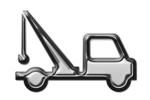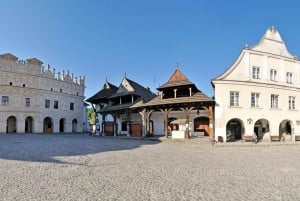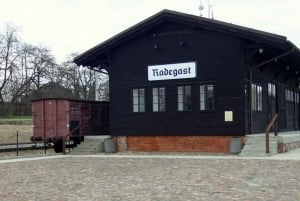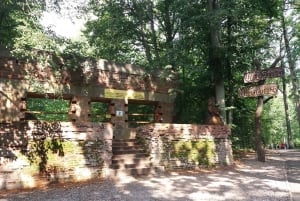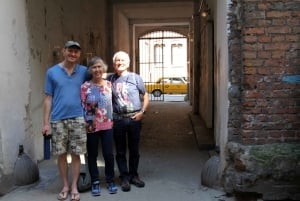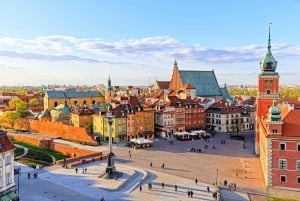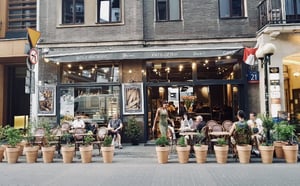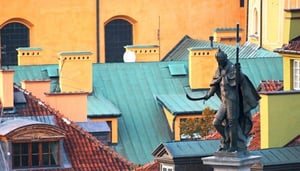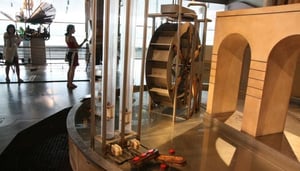Driving in Poland
While Poland’s cities are well-connected by an extensive system of motorways, Polish roads can be a bit of a shock for the uninitiated driver. Many a traveler, used to the comfort of eight-lane thoroughfares, has sat in a jam on a two-lane road leaving the city limits, looking longingly into the distance for the first sight of a motorway on-ramp… only to realize hours later that this bumpily-paved neighbourhood street is the motorway. When planning a road trip that takes you a good distance across the country, you should probably estimate your driving time to be significantly longer than you’d expect at home. However, with money coming in from the EU for road works, the state of inter-city roads has greatly improved in recent years, with some major cities remarkably well-connected by multi-lane highways.
ROAD SAFETY
Especially in the city, drivers should be wary of extremely poor paving, particularly toward the end of the winter, when thaws can cause cracks and even great gaping holes to appear. (These holes are normally patched up quickly, but reappear with alarming regularity, and can be deceptively deep.)
With the state of the roads as it is, you would expect Polish drivers to exercise extreme caution whenever making a foray into the city streets. Not so. A lifetime of summer holidays spent trying to pass and dodge massive speeding lorries on poorly-lit, unevenly-paved, narrow two-lane inter-city roads leaves the average Polish driver with a sense of invincibility behind the wheel, encouraging him to treat many traffic regulations as freedom-limiting guidelines that are meant only for the weak and inexperienced. The result is something entirely incongruent with the warm, patient and solicitous Polish character, and foreign visitors should remember to exercise more than their normal degree of caution when navigating city-centre traffic jams and express lanes.
PARKING
While city streets tend to be narrow, city sidewalks are often uncommonly wide – not for the convenience of pedestrians, who should watch out for cars suddenly bursting over the curb, but for the convenience of city-centre parking. Zones where it is permitted to park on the sidewalk or street side are clearly signposted. Paid parking zones have easy-to-use coin machines.
If you drive out of the city to a countryside location (such as castles, viewpoints or short hiking trails), you will often find that the roped-off parking area displays no signs indicating rates or payment regulations, and the guard on duty (usually a little old lady in a kerchief) will simply approach each car individually and tell you how much to pay (normally a few coins). At busier locations, they may go to the trouble of writing down license plate numbers and even giving you a receipt, but at smaller, out-of-the-way sites you can expect parking attendants to rely solely on memory. Note that in some villages with a major attraction like a castle, locals make money by charging for parking on their private land. It doesn’t normally cost a fortune, but don’t be fooled – drive a bit further and park at the side of the road for free.
REGULATIONS
The minimum driving age is 18. Drivers should carry a valid license, car registration papers and insurance documents with them at all times. All valid EU driving licenses should be accepted in Poland. Residents from outside the EU should obtain an international driving permit before arriving. It’s sometimes possible to apply for an international driving permit at your consulate, but this could take several days or weeks to process.
Standard legal driving limits, unless signposted otherwise, are:
Some residential zones: 20km/h (13mph)
Built-up areas, daytime (5:00 to 23:00): 50km/h (31mph)
Built-up areas, nighttime: 60km/h (37mph)
Outside built-up areas: 90km/h (55mph)
Express roads (2 x 1 lane): 100km/h (62mph)
Express roads (2 x 2 lanes): 110km/h (68mph)
Motorways: 130km/h (80mph)
Minimum speed on motorways: 40km/h (24mph)
Daytime running lights are required for all vehicles at all times; infringements of this regulation bring a stiff fine. Seat belts are compulsory. You must also carry a warning triangle at all times (compulsory for vehicles with more than two wheels), and vehicles registered in Poland must have a fire extinguisher. Visitors driving in Poland should carry a first aid kit and replacement bulbs. Spiked tires are prohibited. Snow chains may only be used on roads covered with snow.
Children under the age of 12 are not permitted to sit at the front. Children under 1.5m tall should be placed in child seats.
The maximum blood alcohol level is 0.02 percent. A heavy fine is imposed and license suspended for levels between 0.021 and 0.05. A driver with over 0.05 percent risks a prison sentence in addition to a fine and license suspension. It is also illegal to use a mobile phone while driving, unless it’s equipped with a hands-free set.
Unleaded petrol, diesel and LPG are available. Most filling stations accept credit cards, and are open 24 hours a day.


